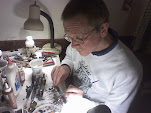I have been following Bob Cordery's adventures with How to Play War Games in Miniature by Joseph Morschauser (copyright 1962) since before Christmas. I had put together the suggested forces for the Modern period version of the rules about ten years ago, using Matchbox military vehicles, readily available at the time, and 1/72 scale plastic figures from ESCI. I wrote up a few little extensions to the rules for aircraft and cover, consistent with the basic flavor of the rules.
Seen below are some of the elements of the task force from the Republic of Green Land, who were facing off against their traditional enemies from the Democratic People's Republic of Brown Land. My older son, Norman, set up the battlefield. He also built the bridge himself, when he was a good deal younger than he is now.

It was agreed that the scenario would be a meeting engagement between 700 point task forces, which would attempt to control a bridge. Both players entered the table on the same side of the river, at opposite ends. Below you can see the advance elements of the Brown force making their way through the town. Buildings are card models from Fiddler's Green, for the most part, and have been stored quite haphazardly for the past ten years.

Here the Brown forces have cleared the town and are confronted by the lead Green elements, commanded by my skating son, William. The river is a no-longer-available piece from Scenic Effects. Roads were laid in quickly with gaffer's tape. There was some dismay when players were reminded that scout cars had no antitank capability, being deemd to be machine gun armed only. Bradleys visible beyond the road represented the brown armored force, and made short work of the Green armor, which was outnumbered 2:1.

Here, toward the end of the game, most of the table can be seen. We agreed that we would play until one force suffered 50% casualties measure in stands rather than points, or until somebody had infantry on the bridge without enemy present for three turns. Each side had chosen a combined arms force of about 40 Basic Units. As I expected, given the somewhat sanguinary and rudimentary nature of the rules, the break point was reached before control of the bridge had been established by either side.

Below, Brown infantry at the end of the game advances to seize the bridge.

It took a little less than two hours to choose forces and play about 8 turns to a conclusion, so it was nice and snappy from that point of view. Norman's comment was that it needs a little more period flavor, and some additional terrain effects would slow the game down a bit and perhaps provide some additional need for maneuver. He also felt that combat was pretty random and needed some further differentiation between weapon and target types. There had been some speculation by Bob Cordery that the armor overrun rule would be too unbalancing; in this game things went about as I had recalled, with nobody using the rule. Infantry in groups outnumbering tanks would leave an overrunning tank to be quickly destroyed by the limited antitank capability of the rifle stands, in the opinion of both commanders. (I had the back end of the Green forces, and didn't have the opportunity to consider an overrun before our morale collapsed.) Since it's all laid out, I might consider a solo game before we clear the table, and see if we might not have done a little better.
All in all, though, it was fun to dust this one off for an idle afternoon.
 Here's a view of the whole set up. One of the two heroes can be barely seen on the far side of the table behind the white hut. Huts and jungle material were borrowed from my Darkest Africa collection.
Here's a view of the whole set up. One of the two heroes can be barely seen on the far side of the table behind the white hut. Huts and jungle material were borrowed from my Darkest Africa collection.








